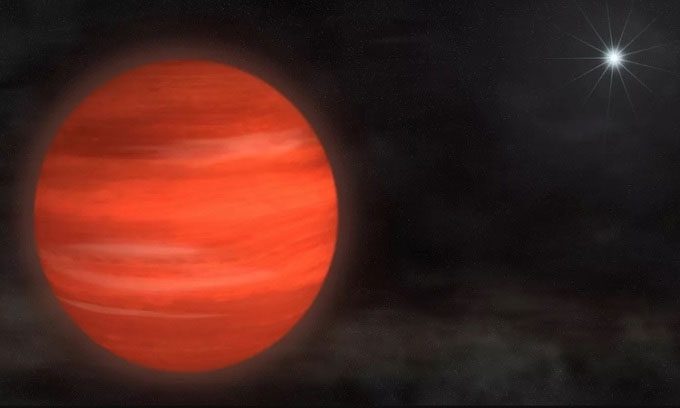Astronomers have discovered exoplanets that are twice the size and over 10 times the mass of Jupiter, yet there are still certain limits to the size of a planet.
Since astronomers first observed beyond the Solar System three decades ago to discover exoplanets, it has been clear that planets in the Milky Way galaxy, and the universe at large, have a wide range of diameters and masses. Before 1992, when the first exoplanet was discovered, Jupiter, the gas giant with a diameter 11 times that of Earth, held the record for the largest known planet. However, Jupiter’s size is relatively modest compared to some of the other giant planets that have been discovered to date, according to Live Science.

The exoplanet Kappa Andromedae b has a mass 12.8 times that of Jupiter. (Image: NASA).
There are two key measurements to consider when determining the size of a planet: diameter and mass. According to the first measurement, the largest known exoplanet has a radius twice that of Jupiter, as stated by Solène Ulmer-Moll, a postdoctoral researcher at the University of Geneva. This object orbits very close to its host star. The width and mass of a planet are related, but they do not always correlate directly. This is because planets vary greatly in density. Some low-mass gas giants can be larger than rocky, dense planets.
For example, the gas giant HAT-P-67 b has a radius twice that of Jupiter and is currently among the largest planets in terms of width. However, this exoplanet, located 1,200 light-years from Earth, has a very low density, making it only one-third the mass of Jupiter, according to Ulmer-Moll. WASP-17 b is also more than twice the size of Jupiter. The next planet, KELT-9b, has a radius 1.84 times that of Jupiter.
Most rocky planets will never reach the size of the aforementioned “super Jupiters”. The largest rocky planets are referred to as “super-Earths”, with a radius up to twice that of Earth. For instance, Wasp-17b has a radius 22 times that of Earth. Although rocky planets are denser than gas giants, they still cannot be as massive. This is because as rocky planets grow, they accumulate gas and ice.
The largest known planet has a mass approximately 13 times that of Jupiter. For example, the gas giant HD 39091 b, located 60 light-years from Earth, has a mass 12.3 times that of Jupiter. Researchers believe it is unlikely to find a larger planet, as a planet will become a “brown dwarf” once it reaches a certain threshold in size and mass.
Brown dwarfs are often referred to as “failed stars” because they are heavier than super Jupiters but not large enough to ignite nuclear fusion in their cores. “The main difference between brown dwarfs and planets is mass and the process of burning deuterium, a heavy isotope of hydrogen,” says Nolan Grieves, a postdoctoral researcher at the University of Geneva. “At higher masses, an object will have enough internal pressure and temperature to burn off most of the deuterium it possesses.”
The largest brown dwarf ever discovered is SDSS J0104+1535, located 750 light-years from Earth at the edge of the Milky Way. It has a mass 90 times that of Jupiter but a radius only 0.7 – 1.4 times that of Jupiter. In fact, it is still smaller than the largest planet in the Solar System.





















































